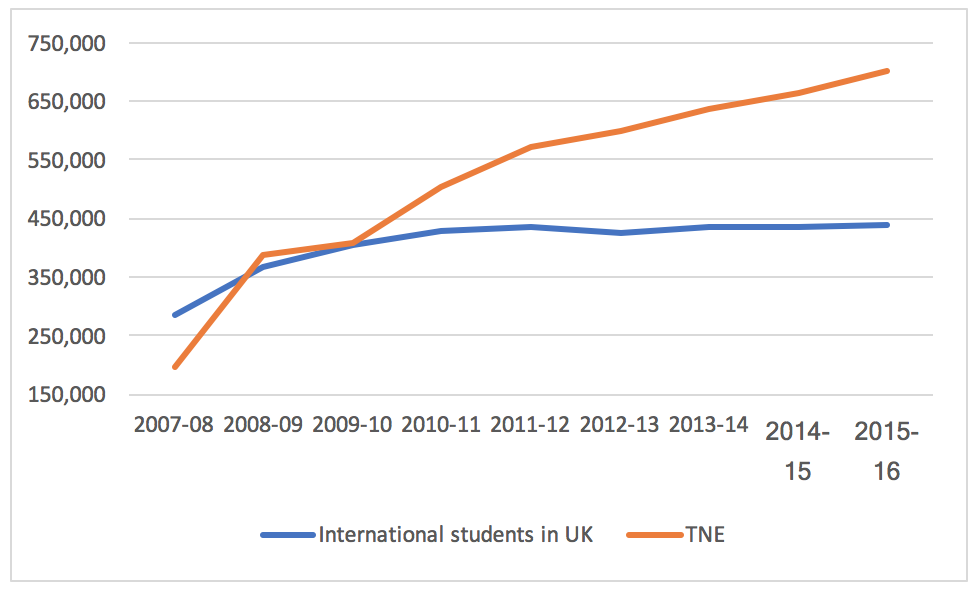UK universities have never been as popular among international students as they are today
“The rationale is clear, if you can’t get international students to the UK then take your degree programmes to them”
While the UK’s onshore international enrolments are in the doldrums, UK HE has never been more popular argues Vincenzo Raimo, pro-vice-chancellor (global engagement) at the University of Reading. He makes the case for increasing TNE activity from UK universities to expand more than just revenue streams.
As the screw has tightened on international student recruitment to the UK since 2010, increasingly its universities have looked to off-shore provision for growth. The rationale is clear, if you can’t get international students to the UK then take your degree programmes to them.
The latest HESA data gives a clear picture of a continuing decline in new international students choosing to study in the UK against a backdrop of growing international demand for higher education and with internationally mobile students at an all-time high[1].
Table 1: enrollment of new international students to UK universities (on-shore)[2]
 Despite this, UK universities have never been as popular among international students as they are today. While international student recruitment to the UK remains in the doldrums, UK university off-shore student enrollments have rocketed, growing by almost 40% between 2010/11 and 2015/16. In 2015/16 there were more than one million international students registered as studying for a UK university award, more than 60% of them based overseas and having no impact on the UK’s immigration debate and whether international students should be in or out of the net migration count.
Despite this, UK universities have never been as popular among international students as they are today. While international student recruitment to the UK remains in the doldrums, UK university off-shore student enrollments have rocketed, growing by almost 40% between 2010/11 and 2015/16. In 2015/16 there were more than one million international students registered as studying for a UK university award, more than 60% of them based overseas and having no impact on the UK’s immigration debate and whether international students should be in or out of the net migration count.
Table 2: International students in UK Universities at home and off-shore[3]
One could deduct from the data (a decline in enrolments at home but growth off-shore) that much of the rationale for the UK’s Transnational Education (TNE) activity is in response to the environment at home, to market demand and motivated by student growth (and tuition fee income).
Of course, there are many reasons other than income for a university to embark on TNE including expanding its provision and footprint, opportunities for enriching its domestic student experience, for the creation of imaginative study opportunities, to leverage collaborative research relationships, for brand development and market penetration and so much more.
At the same time, TNE has never been easier as a result of the rapidly declining costs of mobility, the spread of new technologies and the dramatic falls in information and communication costs. And above all, the sheer demand for higher education which national systems across much of the world are just unable to satisfy without the addition of provision from foreign providers.
The question UK universities must face is can they afford to be involved in TNE? While at the same time asking themselves can they afford not to be involved in TNE?
At the heart of these questions are the rationale and motivations behind university TNE strategies, the types of TNE activity they wish to develop and the timescales in which ambitions might be realised.
There is clearly a whole spectrum of TNE models which universities might adopt, from distance and e- learning, validation and franchise exercises, split-site and partnership programmes, right through to bricks and mortar branch campuses. The types of TNE a university develops depend significantly on their motivations for TNE and their institutional risk appetites.
Figure 1: TNE Risk Scales
 But one thing that’s generally common among the different forms and approaches, is that TNE is a long-term game and unlikely to realise its full benefits during the tenure of a single vice chancellor or, for that matter, a pro-vice chancellor for global engagement.
But one thing that’s generally common among the different forms and approaches, is that TNE is a long-term game and unlikely to realise its full benefits during the tenure of a single vice chancellor or, for that matter, a pro-vice chancellor for global engagement.
Branch campuses are at the most visible end of TNE, requiring high levels of commitment and typically at the higher end of the TNE financial risk scale. They so though come in many forms, sizes and shapes and in part it depends on how you define them. But according to the OBHE’s most recent report on branch campuses, there are 39 international branch campuses (IBCs) of UK universities around the world including Lancaster (Ghana), Liverpool (China), Middlesex (Dubai, Mauritius, Malta), Southampton (Malaysia), and Reading (Malaysia). The OBHE reports that a further 20 IBCs are in development, with at least half of these ventures of universities based in the US and the UK.
Probably the best known and the longest established multidisciplinary branch campuses, are those of the University of Nottingham in Malaysia (established 2000) and China (2004). The wider benefits of these campuses to Britain’s Global University are evident in terms of brand and reputation, reach, programme development, opportunities for staff and students and increasingly now also in research.
Nottingham’s outward student mobility is impressive by anyone’s standards and clearly helped by its cross-border inter-campus student traffic, and developments such as Crops for the Future in Malaysia show how branch campuses can have high quality, impactful research agendas.
But do branch campuses make money which directly benefits the home campus (if that’s a motivation)?
“Long-established IBCs tend to focus on the wider benefits of their international presences to the home campuses rather than on the direct financial return”
This is a much more difficult question to answer and almost impossible to find out from the level of detail published in university financial statements. We can though see from the University of Nottingham’s financial statement for 2015/16 a small direct loss (£0.9m) from its campuses in China and Malaysia. While Liverpool University’s financial statement for 2015 reports a tiny pre-tax surplus of £0.2m but also its share of net liabilities of -£5.5m for XJTLU. On the other hand, both Liverpool and Nottingham report significant full-fee paying international student intakes from the countries in which they have IBCs to their UK campuses; is this the real financial benefit of IBCs, providing a secure student pipelines to the UK?
In general though, Nottingham, Liverpool and other UK universities with long-established IBCs tend to focus on the wider benefits of their international presences to the home campuses rather than on the direct financial return of the overseas operation. As a prominent vice chancellor has been known to say about branch campuses, “there are much easier ways of making money”.
The conclusion is clear, TNE, in all of its forms, can provide significant benefits to the home university (as well as the countries in which they are located). Many of those benefits will be difficult to monetise in a way UK universities are increasingly challenged to do, and they will take time and require patience and persistence in order to achieve the kinds of sustainable longer-term benefits which Nottingham is achieving.
[1] For international students trend data in the US see: http://www.iie.org/Research-and-Publications/Open-Doors/Data/International-Students/Enrollment-Trends#.WNQyUfnyjcs; for Australia: https://internationaleducation.gov.au/research/International-Student-Data/Documents/MONTHLY%20SUMMARIES/2017/Jan%202017%20MonthlyInfographic.pdf
[2] HESA Student Record
[3] Janet Ilieva based on HESA Student Record and Aggregate Offshore Record

Leave a Reply